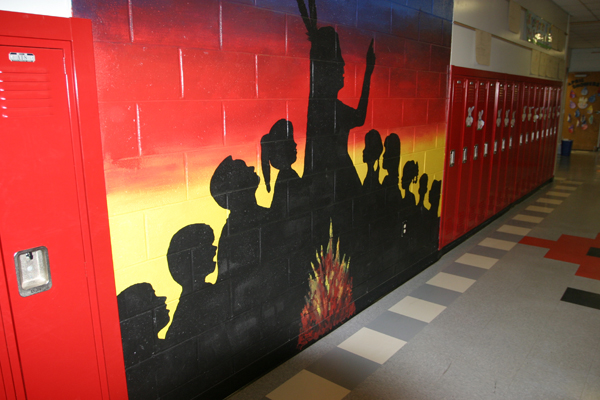Life on the Reservation
Jamie Oppenheim | Jun 04, 2009 | Comments 1

Mural inside the Nah Tah Wahsh Public School Academy in the Hannahville Indian Community. JAMIE OPPENHEIM/ Covering Education
By JAMIE OPPENHEIM
HANNAHVILLE, Mich. — The 13 students in Kristina Hansen’s third-grade class want students in Detroit to know they do not live in teepees.
The students at Nah Tah Wahsh Public School Academy, a tribal charter school on the Hannahville Indian Reservation, spent 15 minutes toward the end of the their second to last class of the day scribbling pen-pal letters to other Detroit third-graders about their lives in Michigan’s Upper Peninsula.
Another popular item on the list of what separates these students from their urban counterparts is that some of the students — the ones who live on the reservation — live down the road from the Island Resort Casino.
Not all of the charter school students live on the reservation. Some of the kindergarten through 12th-grade students live in neighboring towns like Escanaba, the largest city (with 13,000 residents) within several miles of the Potawatomi tribe, or in Gladstone, a town with a population of 5,000.
The school, which started as an Indian school in 1976 and became a charter in 1995, is nearly two miles down a wooded road. It now serves about 150 students. A few houses and the Potawatomi Cultural Center dot the path from the main highway, Highway 2, where the Island Casino Resort also sits. The casino is a multi-story, white building, and its large concrete parking lot and towering size make it look out of place with the rest of its surroundings.
Nine miles to the east of the reservation is the city of Escanaba. Other than that, the road to the reservation from Escanaba is sparsely populated. A few tourist gift shops, motels and camping grounds lay sleepily on the roadside, waiting for summer traffic.
The leaves of the deciduous trees still haven’t bloomed, and a slight winter chill lingers in the air. In the months of June, more cars of vacationing families looking to spend time at the lake should pass through the area and fill up the empty parking spaces.
Although the school accepts any type of student, there are indications throughout the hallways that the primary population served is American Indian. Near the front office hangs a large dream catcher, and the red, black and white tile floor mimics a native design.
In the school’s culture classroom the smell of burnt sage lingered. Around the top walls of the room hung posters representing the Seven Grandfathers. Each Grandfather stands for a different behavior tribe members should strive for, including respect, truth, honesty, patience, humility, bravery and love.
On Mondays students participate in weekly cultural ceremonies and learn lessons about the Seven Grandfathers, said Gloria Wandahsega, one of the school’s culture teachers.
Students also learn the basics of the Potawatomi language, an Algonquian language that fewer than 100 people speak. The school originally taught the Ojibwe language, but fear that Potawatomi may die out prompted some of the teachers at the school to try to preserve the Potawatomi culture through language, Wandagashega said.
Most of the parents of Potawatomi students do not speak the language either, because Potawatomi was not taught in schools and tribal children were forbidden to speak it.
The tribe, which is the only Potawatomi tribal school to teach the language, has made a greater effort to spread the language to the adult tribal members by offering language classes at the cultural center.
Lori Boulley, the school’s other high school teacher, said if students learn their language, they will understand the backbone of their culture.
— Jamie Oppenheim
Filed Under: Michigan • Reshaping Communities
About the Author:














Thanks for the article, I will bestow this website to my bookmarks, my acquaintance just made mention to me about this the other day. gracias